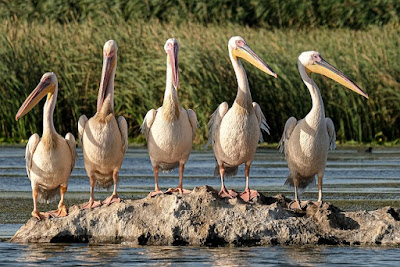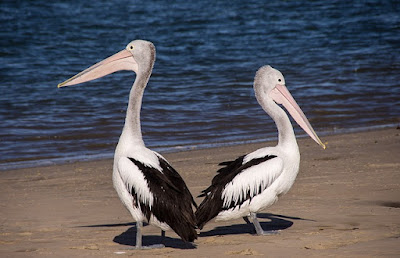Pelicans are among the most captivating and iconic birds that grace our planet's waters. These large, beautiful creatures are renowned for their distinctive appearance, fascinating behavior, and their importance in the ecosystem. In this article, we will delve deeper into the world of pelicans, exploring their characteristics, habitat, behavior, and the important role they play in maintaining the delicate balance of nature.
Anatomy and appearance
Pelicans belong to the Pelicanidae family, which consists of eight species, and have notable characteristics. These aquatic birds have long, powerful wings and webbed feet, making them well equipped for their life on the water. What sets them apart is their large, unmistakable beak, which is both strong and flexible. This beak is distinctive for its huge throat pouch, often referred to as a gular pouch. The sac can expand like a balloon to help them capture and carry fish, which is their primary diet. Pelicans have a unique and beautiful beauty, with pure white or gray feathers and contrasting black feathers.
Habitat and Distribution
Pelicans are widespread and adaptable, living on every continent except Antarctica. They are commonly found in coastal and inland waters, often congregating in large flocks near shorelines. Different species have different preferences for their habitat. For example, the American White Pelican is known to live in freshwater lakes and marshes, while the Brown Pelican prefers coastal areas and saltwater environments.
Behavior and diet
Pelicans are famous for their unique fishing techniques. When hunting fish, they use their keen vision to spot fish swimming near the surface of the water. With incredible precision, they dive straight into the water from heights of up to 60 feet (18 m), using gravity to their advantage. As they dive, they open their huge beaks, creating a pouch to extract fish and water. The pouch can hold up to three gallons (11 litres) of water, which they then expel through a small hole, allowing them to swallow their catch.
These birds are often seen fishing together, feeding in shallow water and cooperatively capturing their prey. Their synchronized and strategic approach to fishing is amazing to watch and underlines the importance of community among these birds.
Conservation and ecological importance
Pelicans play an important role in maintaining the health of aquatic ecosystems. As apex predators, they help control fish populations, preventing overpopulation and imbalances in the food chain. Additionally, their waste contributes nutrients to the aquatic environment, benefiting both plant and animal life.
However, like many other species, pelicans face threats to their survival, primarily from habitat destruction, pollution, and disturbance caused by human activities. Conservation efforts have been vital in preserving these magnificent birds, with organizations working to protect their habitats and raise awareness of the importance of pelicans in our ecosystems.
Pelicans are more than just an attractive bird species; They are guardians of our waterways and essential contributors to the health of our ecosystems. Their unique appearance and remarkable fishing techniques make them fascinating to watch, while their ecological role underlines their importance in maintaining the delicate balance of nature. As we continue to appreciate these remarkable birds, let us also strive to protect their habitats and ensure the continued existence of these beautiful waders for generations to come.
Here are some interesting facts about pelicans:
- Species Diversity: There are eight species of pelicans around the world, varying in size, color, and habitat. Some of the most famous species include the American White Pelican, Brown Pelican, and Dalmatian Pelican.
- Giant Beak: The pelican's bill is long, strong with a pouch that can expand like a balloon. The pouch is used for catching and storing fish during hunting. It can hold up to three gallons (11 litres) of water and fish.
- Soaring flight: Pelicans are adept fliers, often gliding effortlessly through the air. They have long, broad wings and can cover long distances during migration.
- High Diving Skills: Pelicans are renowned for their superb diving abilities. When hunting fish, they can dive from heights of up to 60 feet (18 m) and be the first to enter the water.
- Coastal and inland habitat: Pelicans are versatile when it comes to their habitat. Some species prefer coastal areas and saltwater environments, while others are found in freshwater lakes, rivers, and marshes.
- Group fishing: Pelicans often engage in group fishing activities. They work together to gather fish in shallow water and then take turns catching their prey.
- Unique mating rituals: During the breeding season, pelicans engage in elaborate courtship displays to attract a mate, including synchronized head turning, mutual preening, and singing.
- Incubation: Pelicans typically lay 1 to 3 eggs, and both parents take turns incubating the eggs. They use their webbed feet to help keep the eggs warm.
- Migration Patterns: Many pelican species are migratory, covering long distances between their breeding and winter residences. This migration is often caused by seasonal changes in temperature and food availability.
- Conservation Concerns: Pelicans face various threats, including habitat destruction, pollution, and disturbance caused by human activities. Conservation efforts are being made to protect these birds and their habitats, to ensure their survival for future generations.
- Ancient Birds: Pelicans are ancient birds, with fossil records dating back 30 million years. They have been a part of Earth's bird kingdom for a very long time.
- Notable Gliders: Pelicans are excellent gliders, and they use thermal air currents to fly long distances with minimal energy expenditure. This makes them efficient travelers during migration.
- Prehistoric Relationships: Extinct pelagornithids, also known as "pseudo-toothed" birds, shared some similarities with modern pelicans, although they were not closely related. These prehistoric birds had tooth-like projections on their beaks and were formidable sea birds of their time.
- Symbolism: Pelicans hold symbolism in various cultures. In Christianity, he is often seen as a symbol of self-sacrifice and charity. In ancient Egyptian mythology, the pelican was associated with rebirth and the afterlife.
- International conservation: Many pelican species are protected by international agreements and conservation laws, such as the Migratory Bird Treaty Act in the United States. The purpose of these regulations is to ensure the survival and welfare of these magnificent birds.




Comments
Post a Comment